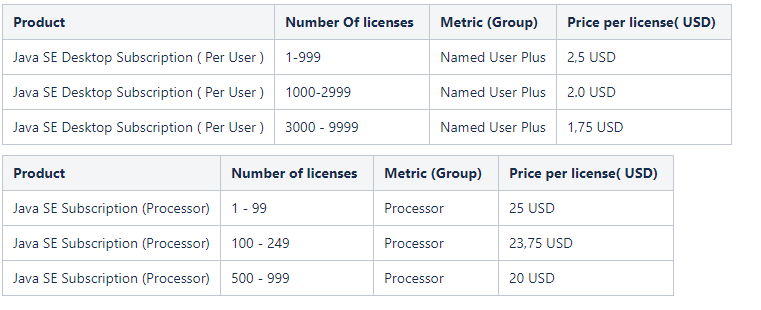Posted in : Applications, Security Av Oliwer Sundgren Översätt med Google ⟶
6 years ago
Under 2018 Oracle released some big and important news regarding the future of Java SE.
The big news is that Java SE requires a payed subscription in order to update the software, this change came into effect on the first on January 2019. In this article I’ll try to explain this new subscription change and how it will affect you.
What does this change mean?
Previously Java SE (which includes the Oracle JRE with Java Web Start) was free, and so was the updates for it. But with this new subscription-based model the updates will no longer be free for commercial use. Since Java is used in a huge variety of applications and browsers, keeping it unpatched is a huge security risk since an unpatched Java opens a lot of doors for unethical hackers.
This means that for every user in a commercial organization you will have to start buying licenses on a per-user based model, where the standard term is one year, and the monthly cost starts at 2,50 USD per user. If you buy licenses in a bigger volume the price will go down a bit.
This change won’t affect personal and non-commercial use.
Non-Commercial use referees to nonprofit organizations.
What does the licensing model look like?
As previously mentioned the licenses are per-user. And the price starts at 2,50 USD. There are also discount tires, for example if you buy more than 999 licenses you pay 2 USD per license instead.
Other than user licenses there is also per-processor license that starts at 25 USD per processor. Just as the user-based licenses, there are also discount tiers with the per-processor licenses as well.
The model combines the license itself and “Oracle Premier support” in the same price.
Below is an example table of how the discount tires work and what the prices are.

What does “Named User Plus” and “Processor” mean?
The definitions of the two different license types are as follows. This is quoted from Oracles pricelist.
- Named User Plus ( per-user licens ):
Defines a user that is allowed to use programs which are installed on a single desktop or multiple desktops regardless of whether the user is actively using the programs at any given time - Processor:
Defines all processors where the Oracle programs are installed and/or running. Programs licensed on a processor basis may be accessed by your internal users and external users.
The number of required licenses is determined by multiplying the total number of cores of the processor by a core processor licensing factor specified on Oracles website.
What are my options?
If you and your organization still require Java for certain applications to work correctly, then you have a few options.
- Buy the licenses:
This is what Oracle wants and expects you to do in order to keep functionality without having to change to much in your environment - Move to Open-source:
As another alterative organizations can choose the open-source route for Java.
OpenJDK and AdoptOpenJDK are both free and open-source versions of Java SE
If you want to know more about this change or if you’re in need of guidance. Don’t hesitate to contact us! You can reach me in the comments of this article or via email on oliwer.sjoberg@xenit.se
Personlig rådgivning
Vi erbjuder personlig rådgivning med författaren för 1400 SEK per timme. Anmäl ditt intresse i här så återkommer vi så snart vi kan.


Add comment